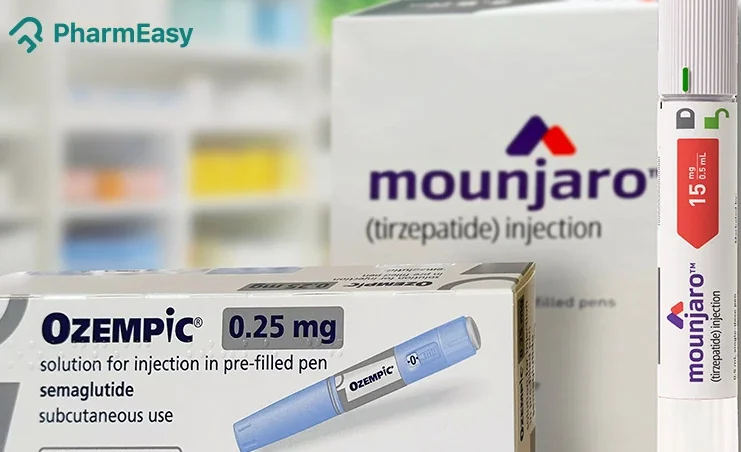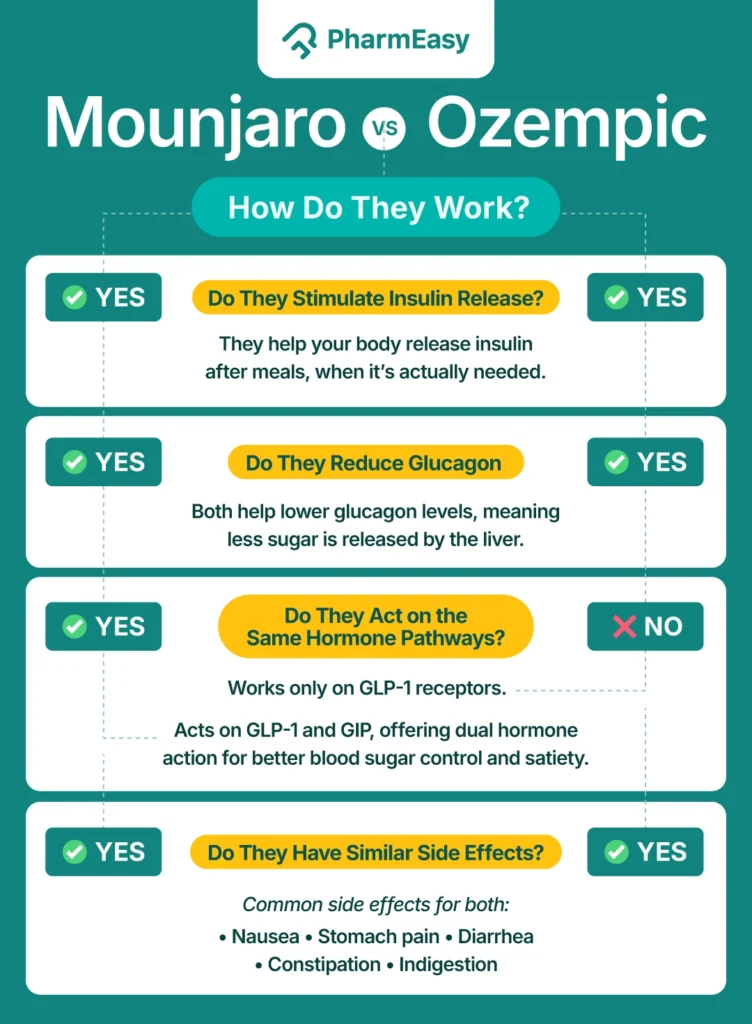Mounjaro vs Ozempic: Our Endocrinologist Explains the Difference
By Dr. Akash N. Shah +2 more

Get,

to manage your symptom
Get your,


4 Cr+ families
benefitted

OTP sent to 9988776655



You’ve successfully subscribed to receive
doctor-approved tips on
Whatsapp

Get ready to feel your best.

Hi There,
Download the PharmEasy App now!!


Register to Avail the Offer
Send OTPBy continuing, you agree with our Privacy Policy and Terms and Conditions

Hi There,
Sign up on PharmEasy now!!
Trusted by 4 crore+ families

OTP sent to 9988776655



You have unlocked 25% off on medicines




Code: NU25
By Dr. Akash N. Shah +2 more
Table of Contents
In India, an estimated 77 million adults are currently living with type 2 diabetes (T2DM)1. In many cases, lifestyle interventions such as diet modification and regular physical activity are sufficient in the early stages of T2DM. However, as the condition progresses, additional treatments may be needed to improve insulin sensitivity or enhance insulin secretion by the pancreas2.
In recent years, medications like Mounjaro and Ozempic have gained widespread attention for their effectiveness in managing type 2 diabetes (T2DM)3,4. Both tirzepatide and semaglutide (active ingredients of Mounjaro and Ozempic) are prescription medications approved by the Central Drugs Standard Control Organisation (CDSCO) and are prescribed under medical supervision5,6. While they share similarities in purpose, their mechanisms of action and dosing differ.

In this article, we aim to provide a neutral, fact-based comparison of Mounjaro and Ozempic to help you better understand each option and support informed conversations with your doctor.
Mounjaro (tirzepatide) and Ozempic (semaglutide) are both injectable medications designed to help manage T2DM in adults, alongside diet and exercise. Below are some brief details of these drug molecules-
Glucagon‐like peptide‐1 (GLP‐1) and gastric inhibitory polypeptide (GIP) are hormones that help regulate blood sugar after meals.
Ozempic works by mimicking GLP-1 only, while Mounjaro targets both GLP-1 and GIP7,8. This dual action makes Mounjaro potentially more effective for blood sugar control compared to Ozempic.

Both Mounjaro and Ozempic are medications (once weekly injections) that work by enhancing the body’s natural hormone responses. Both should be used in conjunction with lifestyle and dietary changes for optimal results3,7,8.
| Feature | Mounjaro (tirzepatide) | Ozempic (semaglutide) |
| Drug Class | GIP & GLP-1 receptor agonist | GLP-1 receptor agonist |
| Stimulates Insulin | Yes (Enhanced due to dual hormone action) | Yes (Via GLP-1 pathway) |
| Suppresses Glucagon | Yes | Yes |
| Lowers Blood Glucose | Highly effective | Effective |
| Weight Loss Effect | Substantial | Significant |
Both Mounjaro and Ozempic have demonstrated strong results in lowering HbA1c, a key marker of long-term blood sugar control. However, their effectiveness can vary depending on individual patient factors such as baseline HbA1c, weight, other health conditions, and treatment adherence.
In a study comparing tirzepatide and semaglutide, tirzepatide reduced HbA1c by 2.01% to 2.30%, depending on the dose, while semaglutide reduced it by 1.86% in 40 weeks13. Thus, Mounjaro (tirzepatide) has the potential for greater reduction in HbA1c levels over time when comnpared to semaglutide.
Important Note: While both drugs are effective, patient response can vary. Factors like side effects, tolerability, cost, and individual goals (e.g., weight loss vs. glycaemic control) often play a role in determining the best choice.
In my experience, medicines like Mounjaro reduce the appetite. Here the role of nutrition plan comes into play. With the limited appetite of the patient- dietitian has to design a nutrient dense meal plan inorder to reduce the chances of nutrtional deficiencies or muscle loss. Many a times we also prescribe nutritional supplements as and when needed. This supports a healthy weight loss.
Dr. Malavika Athavale, Consulting Clinical and IBS Nutritionist
While Mounjaro and Ozempic are primarily approved for managing T2DM, many patients may also experience weight loss as an added benefit of treatment. This reduction in weight is largely due to the medications’ effects on appetite regulation, insulin sensitivity, and slower gastric emptying3,8. In a study comparing tirzepatide and semaglutide, at 12 months, treatment with tirzepatide lead to 6.9% higher weight loss as compared to treatment with semaglutide14.
However, it’s important to note:
Weight management can be a valuable secondary outcome for people with T2DM, as it often improves insulin sensitivity, lowers cardiovascular risk, and enhances overall metabolic health4,10. As always, these benefits are most effective when paired with a healthy diet, regular physical activity, and ongoing medical guidance.
Both Mounjaro and Ozempic are generally well-tolerated, but like all medications, they can cause side effects, especially during the initial weeks of treatment as the body adjusts7,8.
The table below shows common similar side effects of Ozempic as well as Mounjaro7,8:
| Side Effect | Mounjaro and Ozempic |
| Nausea | Common |
| Vomiting | Common |
| Diarrhea | Common |
| Constipation | Common |
| Decreased appetite | Common |
| Fatigue | Rare |
| Injection site reactions | Rare |
| Hypoglycemia (low blood sugar) | Possible |
Other rare but serious side effects of both these medications include:
Also, semaglutide has been linked to a higher risk of worsening diabetic retinopathy15. However, further studies are needed to confirm this association.
Important: Both medications include a boxed warning and should be avoided in patients with a personal or family history of medullary thyroid carcinoma (MTC) or multiple endocrine neoplasia type 2 (MEN 2).
Also Read: Liraglutide: Uses, Dosage, Side Effects & Complete Patient Guide
Mounjaro and Ozempic are widely available in many countries, where they can be purchased with a prescription from major pharmacies. The cost of initiation dose of Mounjaro starts from about three thousand five hundred rupees per injection in India.
While Mounjaro may be a more affordable alternative, the actual medication cost for both can vary based on location, dosage, and healthcare/insurance coverage.
Also Read: Wegovy Diet Plan: Complete Food Guide, Side Effect Management & Meal Ideas
The choice between Mounjaro and Ozempic often depends on individual needs and treatment goals.
For patients already using a GLP-1 receptor agonist but needing stronger blood sugar and weight control, tirzepatide may offer added benefits because of its dual-action mechanism. Also, due to its dose-dependent action, those with high baseline HbA1c levels might respond better to Mounjaro13.
Ultimately, an Endocrinologist’s assessment is essential to determine which medication is more suitable, based on medical history and individual treatment goals.
Note: Both Ozempic and Mounjaro are effective for diabetes management, but Ozempic vs Mounjaro for diabetes often comes down to other factors like patient response, tolerability, cost, and other health conditions.
Some patients may consider switching from Ozempic to Mounjaro if they are not seeing the desired results in blood sugar control or weight management16. However, switching between medications depends on several factors, like current response, side effects, dosage, and overall health. Remember, for a safe and effective transition plan, always consult your doctor. Self-switching or overlapping treatments can lead to risks and are not recommended.
Also Read: Wegovy (Semaglutide): How It Works, Who It’s For & What to Expect
Mounjaro and Ozempic are both effective options for managing T2DM, but they differ in how they work and their potential impact on blood sugar and weight. Mounjaro is a dual GIP/GLP-1 receptor agonist while Ozempic only targets the GLP-1 receptor, thereby providing better blood sugar control. Additionally, when comparing Mounjaro vs Ozempic for weight loss, clinical trials suggest that Mounjaro may lead to greater weight reduction. Ultimately, the best choice depends on individual factors such as tolerability and cost, treatment goals, and medical history. Always consult your doctor or diabetes specialist to determine which medication is right for you.
Clinical studies suggest that Mounjaro may lower A1C more effectively than Ozempic, especially at higher doses7. However, individual results may vary. Therefore, the choice between Mounjaro vs Ozempic in type 2 diabetes should depend on medical advice as well as individual treatment goals.
No, not exactly. Both are injectable medications used to manage T2DM, but they belong to different classes2,5:
-Ozempic is a brand name for the drug semaglutide, which is a GLP-1 receptor agonist that activates one hormone pathway.
-Mounjaro is a brand name for the drug tirzepatide, which is a dual GIP and GLP-1 receptor agonist, meaning it activates two hormone pathways instead of one.
Yes, both drugs share certain common side effects, including nausea, vomiting, diarrhoea, constipation, and appetite loss. Serious but rare side effects (such as pancreatitis or thyroid tumours) are also similar and require medical attention if symptoms appear3,4.
The cost of Ozempic vs Mounjaro can vary widely depending on region, availability, dosage, and pharmacy.
Disclaimer: The information provided here is for educational/awareness purposes only and is not intended to be a substitute for medical treatment by a healthcare professional and should not be relied upon to diagnose or treat any medical condition. The reader should consult a registered medical practitioner to determine the appropriateness of the information and before consuming any medication. PharmEasy does not provide any guarantee or warranty (express or implied) regarding the accuracy, adequacy, completeness, legality, reliability or usefulness of the information; and disclaims any liability arising thereof.
Comments

Leave your comment...
You may also like
Comments